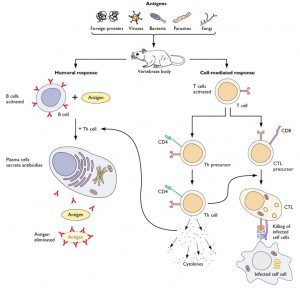1. Provides an
immediate nonspecific immune response
a. The innate, or nonspecific, response immunity is the
defense in which humans are born with, protecting them against harmful
antigens. It involves barriers including secretory molecules and cellular
components. The innate immune system also acts as the first line of defense,
present and ready to be action against intruders upon infection. It is not
antigen specific and responds equally to a variety of harmful substances
without tracking any biological memory of the harmful antigen. Some examples of
the nonspecific immune response include the cough reflex, enzyme in tears and
skin oils, mucus (traps bacteria and small particles), skin, and stomach acid. It
includes the integumentary system (skin/mucus), respiratory system (trachea/nasal
passages/lingings) , and digestive system (stomach acids and enzymes.
2. Activates T
and B cells in response to an infection
a. Most of the immune system consists of white blood
cells. White blood cells vary in many different types and of those types, the
two most prominent are the lymphocytes (T Cells and B Cells). T cells (help
activate B cells to divide into plasma cells, call in phagocytes to destroy
microbes, and activate killer T cells) are critical to the immune system and help destroy
infected cells and stimulate overall immune response. The T cell possesses a
molecule on the surface (T-cell receptor) that interacts with molecules called
MHC (major histocompatibility complex). MHC helps the T cell recognize harmful
antigens and is also on the surface of most other cells in the body. B cells
have the ability to recognize free floating antigens, make antibodies that bind
to antigens, and mark the antigen for destruction by cells from the immune
system. B cells can differentiate and
produce into antibody. However, they rely on T cells to provide to signal to
begin maturation. Once the signal is sent, the B cells produce plasma which in
turn secretes large amounts of antibodies.
3. Responds to
a later exposure to the same infectious agent
a. The adaptive immune system, the specific immune
system, acts as second line defense after the innate immune system response and
also provides protection to re-exposure to the same infectious agent. Unlike
the innate immune system, the adaptive immune system requires some time to
react against the invading organism. The adaptive immune system is also antigen
specific and reacts only with the organism that induced the response. The
adaptive immune system also demonstrates immunological memory, “remembering” (Portion
of T and B cells differentiate into memory cells to quickly respond to the same
antigen) that it has encountered the invading organism, reacting exponentially
faster to the same exposure. Doctors take advantage of this memory to artificially
induce defense against an antigen via vaccination.
4. Distinguishes
self from nonself
a. Every body cell carries distinctive molecules that
identifies itself. The body’s immune
system does not usually attack tissues that carry the self-identifying marker.
It coexists with other body cells in a state called self-tolerance. When the
immune system detects cells or organisms that carry “foreign” molecules, it
immediately acts against them. Any tissue or cells from another individual
(except from an identical twin) are rejected. This is why patients who taken on
transplants must take anti-rejection medicine. The body will even reject
proteins unless it is first broken down into its primary non-antigenic building
block form. The body detects foreign objects by epitopes which protrude from
the surface of the foreign organism. In abnormal situations, however, the
immune system may misidentify itself as a foreign substance and carry an immune
attack on it. This response is called autoimmune disease. Allergies occure
because the immune system is being triggered (cat fur, pollen, etc.) to set off
a response.


